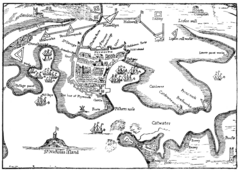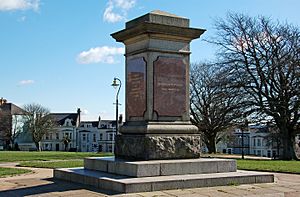Siege of Plymouth facts for kids
Quick facts for kids Siege of Plymouth |
|||||||
|---|---|---|---|---|---|---|---|
| Part of First English Civil War | |||||||
 Contemporary map of Plymouth |
|||||||
|
|||||||
| Belligerents | |||||||
| Commanders and leaders | |||||||
|
|
||||||
| Strength | |||||||
| 2,500 | |||||||
The Siege of Plymouth was a long event during the First English Civil War. This war was a big fight between the King's supporters, called the Royalists, and the Parliament's supporters, known as the Parliamentarians. During the siege, Royalist forces tried to capture the town of Plymouth in Devon, which was held by Parliament's army.
Plymouth was mostly cut off from the land for a long time, from August 1642 to January 1646. However, the Parliamentarians controlled the sea. This meant they could easily bring in supplies and more soldiers by ship.
The Royalists knew it would be very hard to take Plymouth because of this. So, they mostly tried to block supplies from coming in by land. They made two serious attempts to capture the town. The first was from October to December 1643, and the second was from January to February 1645. Plymouth was finally safe in February 1646, when the siege ended.
Why the Siege Happened: The Start of the War
When the English Civil War began in August 1642, Parliament's forces quickly took control of many areas in southern and western England. This included important ports like Plymouth and Exeter. They also had most of the Royal Navy, which was the King's fleet of ships. This control stopped the Royalists from bringing in weapons and soldiers from other countries in Europe.
Soon after the war started, Royalist forces surrounded Plymouth. They set up their main camp in nearby Plymstock. They stopped food and other goods from coming into Plymouth by land. They also blocked the fresh water supply. Many people from the countryside came to Plymouth for safety, making the population grow to over 10,000. This crowded situation led to diseases like typhus spreading.
The Royalist army did not have enough power to take Plymouth by force. They sent a message asking the town to give up, but the town leaders refused and told the messenger not to return. Parliament sent more soldiers and supplies to Plymouth by sea. Every man in the town had to promise to defend Plymouth until the very end.
By late September 1642, Parliament controlled Devon, while Royalists led by Sir Ralph Hopton held Cornwall. At the start of the war, most soldiers on both sides were not well trained. But Plymouth was different. Its army was led by Colonel William Ruthven and included experienced Scottish soldiers. These Scots had stopped in Plymouth on their way back from Ireland. The town leaders hired them to help defend the city.
Parliament's control of the navy made Plymouth very strong from the sea. Ships could bring in supplies and soldiers whenever needed. The soldiers in Plymouth built strong defenses on high ground to the north. They built forts at places like Lipson, Holiwell, and Stonehouse. These forts made it very hard for the Royalists to attack the town from land.
In June 1643, the Royalists won a big battle at Roundway Down. This victory left Parliament's forces in the west of England cut off. On July 26, Prince Rupert captured Bristol, which was the second-largest city in Britain. This gave the Royalists a place to land more soldiers from Ireland. Exeter also surrendered to Prince Maurice on September 4. This left Plymouth as the only major place in the West Country still held by Parliament.
The Royalists' success caused some people to switch sides. One example was Sir Alexander Carew, who was in charge of Drake's Island. This island was a very important defense point. In August, Carew tried to make his men fire on a Parliament ship entering the harbor. They refused, and he was arrested. He was later executed for treason.
The First Major Attack: 1643 Siege
Instead of attacking Plymouth right away, Prince Maurice first captured Dartmouth. This took until early October. Royalist horsemen started blocking land routes to Plymouth on September 15. But the main siege operations did not begin until mid-October. This delay allowed London to send 500 more soldiers to Plymouth. These soldiers were led by Colonel James Wardlow, an experienced officer who became the new commander of Plymouth's defense.
On October 21, the Royalists began preparing to attack Fort Stamford. This fort was on a small piece of land sticking out into the water. The Royalists thought it controlled Plymouth Sound, the entrance to the harbor. Even though Parliament's soldiers tried to slow them down, the fort was captured on November 5. However, the Royalists did not gain much from this win. Cannons placed at Fort Stamford could not stop ships from entering Plymouth Sound and bringing supplies to the town. Losing this fort also meant the Plymouth defenders had fewer places to guard, which helped them.
The Parliamentarians easily pushed back other Royalist attacks. The most serious attack happened on December 3. Led by a local guide, the Royalists used the low tide to capture a small outpost at Laira Point. Parliament's soldiers tried to take it back but had to retreat to what is now 'Freedom Fields Park'. They held their ground there for several hours. This gave more Parliament troops time to gather. The Royalists were outnumbered and had to retreat. Many of their soldiers were cut off by the incoming tide. The siege was officially ended on December 25. However, the Royalists kept Fort Stamford and continued to block land routes.
After 1643: Continued Blockade and Final Relief
In January 1644, Colonel Gould replaced Wardlaw as commander of Plymouth. The land blockade was lifted for a short time in July when the Earl of Essex brought his army into the South West. Colonel Gould died in July, and Colonel Martin took over. Martin started a plan of constantly attacking Royalist outposts.
After defeating Essex's army in September 1644, the main Royalist army from Oxford, led by King Charles I, arrived outside Plymouth. They demanded that the town surrender. But since Parliament still controlled the sea, they could send supplies and more soldiers. One of these new soldiers was the experienced Colonel John Birch. This allowed Plymouth's defenders to refuse the King's demands. King Charles needed his army elsewhere, so he left only a small force under Sir Richard Grenville to continue the blockade.
Grenville launched a big attack in January 1645. He captured some of the forts outside Plymouth but was eventually pushed back. In February, Plymouth's soldiers took back Mount Batten. This marked the end of serious attempts by the Royalists to capture the town. The blockade finally ended in December 1645, when the New Model Army, Parliament's main army, arrived in the West Country.


